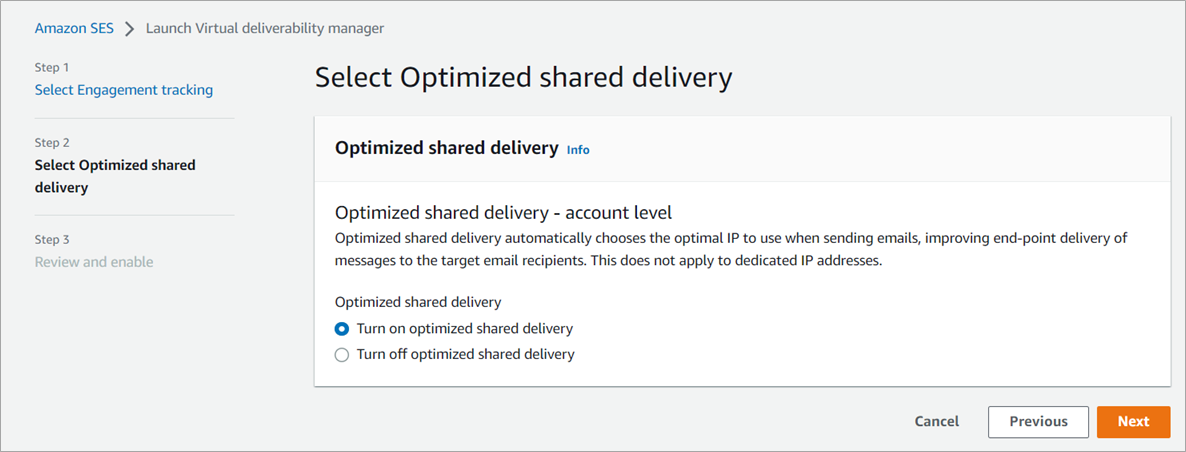Post Syndicated from sakoppes original https://aws.amazon.com/blogs/messaging-and-targeting/improve-email-delivery-rates-with-email-delivery-and-engagement-history-for-every-email/
Email is a ubiquitous way to reach customers, whether to stay in touch, offer new services, or inform customers of product changes or transaction status. Amazon Simple Email Service helps customers send hundreds of billions of emails each month, and now offers more tools to improve email delivery rates and explore campaign success. SES’ Virtual Deliverability Manager now supports email delivery and engagement history, giving customers the ability to easily troubleshoot and investigate email delivery activities. Customers can verify the delivery of emails, identify the source of deliverability challenges, and find means to improve their email delivery rates. This reduces the effort needed to debug delivery problems, and lowers the mean time to resolution when responding to email delivery operational events.
How did Amazon SES’ deliverability features work before?
Previously, customers could get powerful insights into their delivery rates using SES Virtual Deliverability Manager, but they could not explore delivery activity at the level of individual messages. Customers could see overall send, delivery, bounce, and open/click rates for their accounts, as well as by mailbox provider (e.g. Gmail or Hotmail), sending email address, and configuration set. These insights were aggregated across multiple emails, making it difficult to find specific examples of failures to support troubleshooting efforts. It was also not possible to verify individual email delivery status and troubleshoot specific failures, which is a common customer support use case. Customers could implement custom solutions tracking delivery events emitted by SES, but this required custom coding and private data store maintenance. Often the associated effort was a barrier to customers, and they simply did not have an effective way to troubleshoot delivery problems at scale.
What new capabilities are available to enhance email deliverability?
Now, customers can see the delivery transaction status and details for every email they have sent in the last 30 days. As an integrated part of the SES Virtual Deliverability Manager experience, customers have a seamless search and drilldown experience built into the AWS SES console, to search for email transaction records and explore delivery status. It’s easy to pivot by multiple criteria, including searches by sending email address, or looking at the emails sent to a specific recipient. Customers can narrow down searches to specific timeframes and sample based on delivery status. The flexible query capabilities of Virtual Deliverability Manager help customers quickly solve a variety of use cases, from verifying whether an order shipment notification has been delivered, to sampling mailbox provider responses to failed email deliveries when investigating a drop in delivery rates.

What can I do with the new email delivery and engagement history capabilities?
Lookup individual email recipient history:
Say you have a customer support team that gets complaints from customers about not getting specific transactional emails, such as a shipping confirmation email. Without a custom solution, it was difficult to confirm whether a specific email sent through SES had indeed reached the target recipient. Now you can look up the recent email history of a single recipient, and quickly see all the emails sent to that recipient with delivery and engagement status. It’s easy to see, for example, if an email bounced because a customer’s mailbox was full. It’s easy to get a fast and concise answer, streamlining investigations into single delivery events.
Understand drops in email delivery rates:
Another interesting case is when you have a drop in deliverability success rates, and you need to find out why. Now you can easily search for emails that bounced within a specific timeframe, and look at the message received from the mailbox provider which describes the bounce reason. These messages often contain useful information, such as identifying messages identified as spam or listed in a public blocklist. You can also see if send actions are failing because recipients are on your blocklist. This helps quickly narrow down the possible root causes to resolve delivery issues quickly.

Find your most engaged customers:
It’s also helpful to be able to find lists of customers who might benefit from focused marketing efforts. When you send emails through SES, you can track whether recipients open the emails and whether they click on links in the content. In aggregate these metrics helps show campaign success, but now you can find out who engaged with your emails to drive further outreach efforts. Searching for emails from a specific sender that have had a click event will give you a list of recipients that may be responsive to further actions. It takes just seconds with Virtual Deliverability Manager, and you can use the Export feature to easily pull your search results into a spreadsheet.

How to get started with email delivery and engagement history:
To get started using email delivery and engagement history, if you have Virtual Deliverability Manager enabled, just open the AWS SES console, navigate to the Virtual Deliverability Manager Dashboard in the left navigation, and click on the “Messages” tab. For customers who wish to enable Virtual Deliverability Manager, just open the AWS SES console and navigate to the Virtual Deliverability Manager page in the left navigation, and follow the instructions to turn on Virtual Deliverability Manager.
If you want to learn more, see the Virtual Deliverability Manager dashboard documentation.

Get started with SES visit https://aws.amazon.com/ses/.





